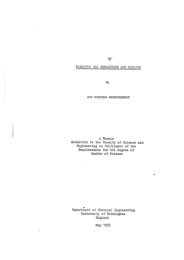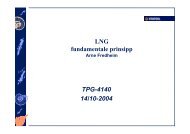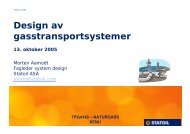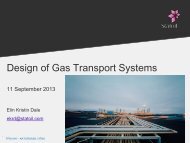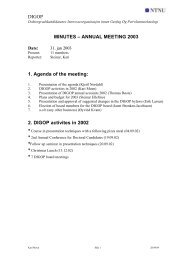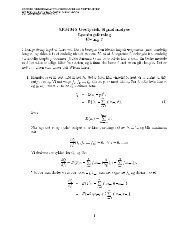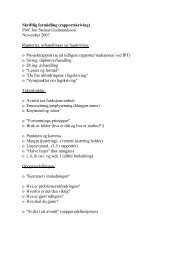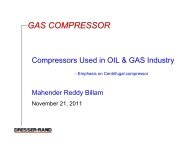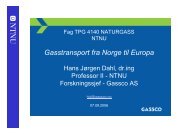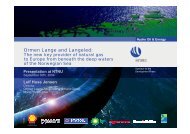Slug Catchers in Natural Gas Production - NTNU
Slug Catchers in Natural Gas Production - NTNU
Slug Catchers in Natural Gas Production - NTNU
You also want an ePaper? Increase the reach of your titles
YUMPU automatically turns print PDFs into web optimized ePapers that Google loves.
Karam – <strong>Slug</strong> <strong>Catchers</strong> <strong>in</strong> <strong>Natural</strong> <strong>Gas</strong> <strong>Production</strong><br />
CHAPTER 5 NORWEGIAN FIELDS AND SLUG CATCHERS<br />
This chapter will describe four different slug catchers from four different fields ly<strong>in</strong>g <strong>in</strong> the Norwegian<br />
cont<strong>in</strong>ental shelf. The Troll field is l<strong>in</strong>ked to an onshore process<strong>in</strong>g plant known as Kollsnes whereas<br />
the Heidrun field has its gas process<strong>in</strong>g activity <strong>in</strong> Tjeldbergodden methanol process<strong>in</strong>g plant. The<br />
Melkøya plant receives the gas from the Snøhvit field while the Nyhamna plant receives the gas<br />
streams from the Ormen Lange field. Follow<strong>in</strong>g that, relevant data are collected and organized <strong>in</strong> two<br />
tables, Tables 2 and 3, to allow a HYSYS simulation of the amount of liquid to be expected <strong>in</strong> the slug<br />
catcher and discuss the design.<br />
5.1 Troll and Kollsnes<br />
Statoil-owned process<strong>in</strong>g plant, Kollsnes, located 67 km west of Bergen started operations <strong>in</strong> October<br />
1996. The location of the plant made it possible to build a simpler platform than what was orig<strong>in</strong>ally<br />
planned. The gas from the Troll field is transported to the Kollsnes plant. In 2005, the gas from both<br />
Kvitebjørn and Visund fields started com<strong>in</strong>g also to the Kollsnes process<strong>in</strong>g plant. The orig<strong>in</strong>al<br />
capacity of the plant was 120 million standard cubic meters per day with the presence of 5<br />
compressors; it is now raised up to 143 million standard cubic meters per day due to the <strong>in</strong>stallation of<br />
a sixth compressor. It can also handle 69 000 barrels of <strong>Natural</strong> <strong>Gas</strong> Liquids (NGL) per day<br />
(Hydrocarbons Technology, 2012). The new plant, which can handle 26 million standard cubic meters<br />
of gas, is now able to process gas from further field developments.<br />
<strong>Natural</strong> <strong>Gas</strong> Liquid is separated from the rich gas at the Kollsnes gas plant and then sent to Mongstad<br />
ref<strong>in</strong>ery through the Vestprosess pipel<strong>in</strong>e <strong>in</strong> order to fractionate gas <strong>in</strong>to propane, butanes and naphtha.<br />
Pressurized dry gas is driven by the large compressors and transported to customers through gas<br />
trunkl<strong>in</strong>es. There are four trunkl<strong>in</strong>es: Statpipe, Zeepipe, Europipe I and Franpipe transport<strong>in</strong>g the gas<br />
to 7 cont<strong>in</strong>ental European countries: France, Netherlands, Belgium, Germany, Czech Republic,<br />
Austria and Spa<strong>in</strong>. It should be noticed that the previously listed trunkl<strong>in</strong>es do not all orig<strong>in</strong>ate from<br />
the Kollsnes plant. Along with the Kårstø process<strong>in</strong>g plant, they constitute 70% of the gas transported<br />
from Norway to Europe.<br />
Page 22 of 56



